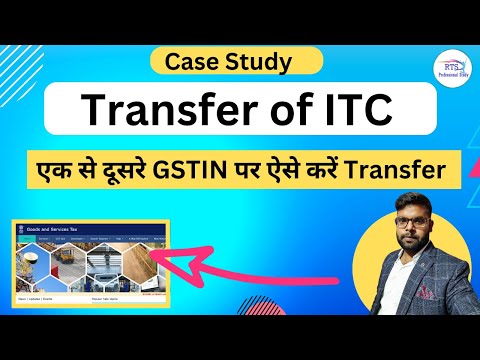Key Takeaways
- GST ITC-02 facilitates the seamless transfer of input tax credits during business reorganizations.
- A valid GST registration for both the transferor and the transferee is essential for filing GST ITC-02.
- Only ITC on inputs, semi-finished goods, and finished goods can be transferred via GST ITC-02.
- Accurate documentation, including a CA certificate and legal agreements, is crucial for compliance.
- Timely and correct filing of GST ITC-02 ensures continuity of tax credits and avoids potential losses.
The complexities of GST can be daunting, especially when it comes to specific forms like GST ITC-02. This form plays a crucial role in the transfer of input tax credit (ITC) in certain situations. But what exactly is GST ITC-02, and why is it important? Let’s dive in and explore everything you need to know about this essential GST form.
What is GST ITC-02?

GST ITC-02 is a form used under the Goods and Services Tax (GST) system in India for the transfer of input tax credit (ITC) from one registered entity to another. This transfer typically occurs during business reorganizations such as mergers, demergers, or the sale of business units. The form ensures that the accumulated ITC of the transferor can be seamlessly passed on to the transferee, maintaining the continuity of tax credits and compliance with GST regulations.
Reasons to File ITC-02
Filing GST ITC-02 is essential for several reasons, primarily related to the transfer of business and ensuring the continuity of input tax credit (ITC). Here are the key reasons:
- Business Reorganization:
During mergers, demergers, or amalgamations, businesses undergo structural changes. Filing ITC-02 allows for the smooth transfer of ITC from the transferor to the transferee, ensuring that the tax credits are not lost in the process.
- Sale of Business:
When a business or a part of a business is sold to another entity, the accumulated ITC needs to be transferred to the new owner. ITC-02 facilitates this transfer, allowing the new owner to benefit from the existing tax credits.
- Transfer of Business Assets:
If a business transfers its assets to another entity, the associated ITC can also be transferred. Filing ITC-02 ensures that the ITC on inputs, semi-finished goods, and finished goods related to the transferred assets is passed on to the new owner.
- Ensuring Compliance:
Filing ITC-02 helps maintain compliance with GST regulations. It ensures that the transfer of ITC is documented and reported to the tax authorities, preventing any potential issues or disputes in the future.
- Avoiding ITC Loss:
Without filing ITC-02, the accumulated ITC of the transferor could be forfeited. This form ensures that the ITC is preserved and transferred, allowing the transferee to utilize it for their GST liabilities.
Legal and Regulatory Requirements:
In certain business transactions, legal agreements or court orders may mandate the transfer of ITC. Filing ITC-02 is necessary to comply with these legal and regulatory requirements.
Pre-conditions for Filing ITC Declaration in FORM GST ITC-02
Before filing GST ITC-02, certain pre-conditions must be met to ensure the proper transfer of input tax credit (ITC). Here are the key pre-conditions:
- Valid GST Registration:
Both the transferor (the entity transferring the ITC) and the transferee (the entity receiving the ITC) must have valid GST registrations. This ensures that both parties are recognized under the GST system.
- Business Transfer:
The transfer of business, whether through a merger, demerger, sale, or transfer of business assets, should be legally recognized. This typically involves a court order, a legal agreement, or other formal documentation validating the transfer.
- Outstanding Liabilities:
The transferor must ensure that all outstanding GST liabilities, including any pending tax payments or returns, are cleared before filing ITC-02. This helps in avoiding any complications or delays in the transfer process.
- Eligible ITC:
Only the ITC accumulated on inputs, semi-finished goods, and finished goods related to the business being transferred can be moved. ITCs on capital goods, services, or ineligible credits are not transferable through this form.
- Proper Documentation:
All necessary documents supporting the business transfer, such as legal agreements, court orders, and a certificate from a chartered accountant or cost accountant, must be prepared and attached with the ITC-02 form.
- Declaration of ITC:
A detailed declaration of the ITC to be transferred, including the GSTIN of both the transferor and transferee and the amount of the ITC, must be provided in the form.
- Cleared Audit:
Any audit requirements or inspections related to the transferor’s GST compliance should be completed and cleared. This helps in ensuring that there are no pending issues that could affect the transfer.
- No Objection Certificate:
In some cases, a No Objection Certificate (NOC) from the tax authorities may be required, especially if the business transfer involves significant changes or high-value ITC transfers.
By filing FORM GST ITC-02, is it possible to transfer any ITC?

Filing FORM GST ITC-02 is a mechanism under the GST law to facilitate the transfer of specific types of Input Tax Credit (ITC) during certain business transactions like mergers, demergers, sales, or transfer of business assets.
Additionally, ITC-02 is the mandatory form for claiming unused ITC on business transfer, according to Rule 41 of the CGST Rules.
However, it is important to note that not all types of ITC can be transferred using this form.
Transferable ITC:
- ITC on Inputs:
Input tax credits accumulated on inputs such as raw materials and consumables used in the production process can be transferred. This ensures that the new entity can utilize these credits to offset its GST liabilities.
- ITC on Semi-finished Goods:
ITC related to semi-finished goods, which are products that are still in the production phase, can also be transferred. This helps in maintaining the continuity of credit for goods that are not yet completed.
- ITC on Finished Goods:
Credits on finished goods, which are ready for sale, can be transferred to the transferee entity. This allows the new entity to benefit from the accumulated credits on goods ready for the market.
Non-transferable ITC:
- ITC on Capital Goods:
Credits on capital goods like machinery and equipment used in production but not sold as part of the business are not transferable. These credits are linked to the original purchaser and cannot be moved to another entity through ITC-02.
- ITC on Services:
ITC on services such as rent, utilities, and professional fees cannot be transferred using FORM GST ITC-02. The organization that originally incurred the expense must use these credits.
- Ineligible Credits:
Any ITC that is blocked under GST provisions, such as credits on personal use items, motor vehicles, or goods given as gifts, cannot be transferred.
Components of a CA Certificate for GST ITC 02
When preparing a CA certificate for GST ITC 02, it is crucial to include specific components to ensure the document is complete and accurate. Here is a detailed breakdown of each component:
- Basic Information
The certificate should start with the basic details of the businesses involved in the transfer. This includes:
- GSTIN of Transferor: The GST Identification Number of the business transferring the input tax credit.
- GSTIN of Transferee: The GST Identification Number of the business receiving the input tax credit.
- Business Name and Address: The names and addresses of both the transferor and transferee businesses.
- Declaration by CA
The Chartered Accountant certifies the accuracy of the information in this section in a formal statement. It typically includes:
- Verification Statement: A declaration that the CA has verified the books of accounts and other relevant records of both businesses.
- Accuracy Assurance: An assertion that the information provided in the certificate is true and correct to the best of the CA’s knowledge and belief.
- Details of Input Tax Credit
This part of the certificate provides a detailed breakdown of the input tax credit being transferred. It includes:
- Total Amount of ITC Transferred: The total value of the input tax credit being moved from the transferor to the transferee.
Breakdown of ITC Components:
- CGST (Central Goods and Services Tax): The amount of central tax credit being transferred.
- SGST (State Goods and Services Tax): The amount of state tax credit being transferred.
- IGST (Integrated Goods and Services Tax): The amount of integrated tax credit being transferred.
- Cess: Any applicable cess being transferred.
- Transfer of Input Tax Credit
This section specifies the details about the transfer process:
- Effective Date: The date on which the transfer of the input tax credit is effective.
- Reference Number: A unique reference number for the transaction, if applicable.
- Signature and Seal
The chartered accountant must duly sign and seal the certificate. This section should include:
- Signature of CA: The CA’s handwritten signature.
- Name of CA: The full name of the Chartered Accountant.
- Membership Number: The CA’s membership number, which verifies their professional accreditation.
- Date of Issuance: The date on which the certificate is issued.
- Seal: The official seal of the Chartered Accountant or their firm.
Can the Claim Be Modified?

Yes, the claim filed through FORM GST ITC-02 can be modified, but there are specific conditions and procedures that must be followed for any modifications to be accepted. Here are the key points regarding the modification of a GST ITC-02 claim:
Conditions for Modification:
- Clerical Errors:
Minor clerical errors, such as typographical mistakes or incorrect entries that do not affect the substance of the ITC transfer, can generally be corrected. These modifications should be straightforward and not alter the overall amount of ITC being transferred.
- Submission Timeline:
Modifications must be made within a reasonable timeframe after the initial filing. The GST portal typically allows for corrections before the authorities process and finalize the claim.
- Approval Requirements:
Significant changes that impact the amount of ITC or the details of the transfer may require additional approval from the GST authorities. This ensures that any substantial alterations are thoroughly reviewed and validated.
Position of the Registered Individual in Case of the Claim Being Accepted or Rejected
When a claim filed through FORM GST ITC-02 is either accepted or rejected, the registered individual, whether the transferor or the transferee, must take specific actions to ensure compliance with GST regulations. Here’s what needs to be done in each scenario, incorporating relevant keywords related to the topic:
In the case of the claim being accepted,
- Update Electronic Credit Ledger:
Both the transferor and transferee must promptly update their electronic credit ledgers to reflect the acceptance of the ITC transfer. This ensures that the input tax credit (ITC) is accurately accounted for in their GST records.
- Adjust GST Returns:
The transferee should ensure that the transferred ITC is properly included in their GST returns, such as GSTR-3B and GSTR-2A. This correct inclusion is crucial for offsetting future GST liabilities.
- Maintain Documentation:
It is important to keep all documentation related to the ITC transfer, including the acceptance notice from GST authorities, business transfer agreements, and supporting documents. Proper documentation is essential for compliance and audit purposes.
- Conduct Audits and reconciliations:
Regular audits and reconciliations should be conducted to ensure the accuracy of the transferred ITC. This helps in identifying any discrepancies early and maintaining compliance with GST laws.
- Communication with Involved Parties:
Effective communication between the transferor and transferee is crucial. Both parties should ensure they are aware of the acceptance and have updated their records accordingly. This ensures transparency and smooth business operations.
- Compliance with Time Limits:
Ensure that all updates and adjustments are made within the prescribed time limits to avoid any penalties or legal issues.
In the case of the claim being rejected:
- Identify Reasons for Rejection:
Understand the specific reasons provided by the GST authorities for the rejection. Common issues include incorrect details, insufficient documentation, or non-compliance with pre-conditions.
- Rectify Errors:
Address the issues that led to the rejection. This might involve correcting inaccurate information, providing missing documents, or fulfilling any compliance requirements.
- Re-submit the Claim:
After rectifying the errors, re-submit FORM GST ITC-02 with the correct information. Ensure that all details are accurate and complete to avoid subsequent rejection.
- Settle Outstanding Liabilities:
If the rejection was due to outstanding GST liabilities, ensure that these are cleared before re-submitting the form. This is crucial for gaining acceptance upon re-submission.
- Seek professional assistance.
Consider consulting with a GST professional or chartered accountant to ensure that the re-submitted claim meets all regulatory requirements and addresses the reasons for the initial rejection.
- Maintain Detailed Records:
Keep a record of the original submission, rejection notice, and subsequent re-submission. Proper documentation helps in addressing any future queries or audits by GST authorities.
Impact on Business Operations:
- For the Transferor Entity:
The transferor must ensure their GST records accurately reflect the status of the ITC transfer. Any discrepancies should be addressed promptly to maintain compliance and avoid penalties.
- For the Transferee Entity:
The transferee needs to closely monitor their ITC claims. If the claim is accepted, they must utilize the credits correctly in their GST returns. In case of rejection, they should work with the transferor to resolve issues and ensure successful re-submission.
Action Required on the Part of Transferee with Respect to GST ITC-02
Here’s what the transferee needs to do:

When a business transfer occurs, the transferee must take several specific actions to ensure compliance with GST regulations and to properly manage the input tax credit (ITC) being transferred via FORM GST ITC-02.
- Acknowledge the Transfer of Liabilities:
Upon the successful filing of GST ITC-02 by the transferor entity, the transferee must acknowledge the transfer of liabilities. This involves updating their records to reflect the newly acquired ITC and associated liabilities. - Submit a transfer request:
The transferee must ensure that a proper transfer request is made on the GST portal. This involves confirming the receipt of ITC from the transferor and verifying the accuracy of the transferred credit. - Provide a Declaration for Transfer:
The transferee must submit a formal declaration confirming their acceptance of the ITC. This declaration should include all necessary details about the transferred ITC, including the amount and the reason for the transfer, such as a demerger scheme or business acquisition. - Compliance with the Demerger Scheme:
If the ITC transfer is part of a demerger scheme, the transferee must ensure compliance with all provisions of the scheme. This includes adhering to any specific conditions laid out in the legal documents or court orders associated with the demerger. - Provision for Transfer of ITC:
The transferee must ensure that the ITC being transferred is correctly reflected in their electronic credit ledger. This involves verifying that the ITC has been appropriately credited under the major heads (CGST, SGST, and IGST) in the ledger. - Update business entity records:
The transferee, as a business entity, must update their financial and GST records to reflect the incoming ITC. This is essential for maintaining accurate accounting records and ensuring smooth compliance during audits. - Utilize Unutilized Credit:
The transferee should utilize the unutilized credit in their GST returns to offset future GST liabilities. Proper utilization ensures that the ITC is effectively managed and used to reduce tax payments. - Monitor confirmation messages:
Pay attention to confirmation messages from the GST portal indicating the successful transfer and acceptance of ITC. These messages are crucial for tracking the status of the ITC transfer and ensuring that it has been correctly processed. - Maintain separate registrations, if applicable:
If the business involves separate registrations for different states or business verticals, the transferee must ensure that the ITC is allocated to the correct GSTIN. This is particularly important for businesses with multiple GST registrations. - Verify information in drop-down lists:
When updating records on the GST portal, the transferee should carefully select the correct options from the drop-down lists to ensure accurate reporting of the ITC transfer. - Ensure compliance with time limits.
All actions related to the ITC transfer must be completed within the prescribed time limits to avoid penalties and ensure compliance. Prompt action is necessary to meet regulatory requirements. - Update the Constitution of Business:
If the transfer involves a change in the constitution of the business, such as a change from a sole proprietorship to a partnership, the transferee must update the GST registration details to reflect this change. - Regular Audits and Reconciliation:
Conduct regular audits and reconciliations of the ITC records to ensure that the transferred credit is accurately reflected and utilized. This helps in maintaining compliance and identifying any discrepancies early. - Maintain comprehensive documentation:
Keep detailed records of all documents related to the ITC transfer, including the business transfer agreement, the ITC-02 form, and any correspondence with the GST authorities. Proper documentation is crucial for compliance and audit purposes.
Information Required to Be Furnished in Form GST-02
When filing Form GST ITC-02 for the transfer of input tax credit (ITC), the following key information must be provided:
Basic Details:
- GSTIN of Transferor: The GST identification number of the entity transferring the ITC.
- GSTIN of Transferee: The GST identification number of the entity receiving the ITC.
Details of the ITC to Be Transferred:
- Amount of ITC: The total amount of input tax credit to be transferred, categorized under major heads (CGST, SGST, IGST).
- Details of Inputs: Specific details of the inputs, semi-finished goods, and finished goods involved in the transfer.
Reason for Transfer:
- Nature of Business Transfer: A description of the business transaction necessitating the ITC transfer, such as a merger, demerger, or sale of business.
Supporting Documents:
- Legal Agreements: Copies of the business transfer agreement or court order validating the transfer.
- CA/Cost Accountant Certificate: A certificate from a chartered accountant or cost accountant confirming the accuracy of the ITC details.
Declaration:
- A formal declaration by the transferor, stating the correctness of the information provided and compliance with GST regulations.
Additional Details:
- Any other specific information required by the GST authorities to validate the ITC transfer.
Ensuring all this information is accurately provided helps in the smooth processing and acceptance of the ITC transfer under GST regulations.
Documents to Be Attached to GST ITC-02

When filing Form GST ITC-02, it is essential to attach the following documents to ensure the smooth transfer of input tax credit (ITC) and compliance with GST regulations:
Business Transfer Agreement:
- A copy of the legal agreement detailing the transfer of business, such as a merger, demerger, or sale of business units.
Court Order:
- If applicable, a court order or other legal documentation validates the business transfer.
Chartered Accountant/Cost Accountant Certificate:
- A certificate from a chartered accountant or cost accountant confirming the accuracy of the ITC details being transferred.
Detailed List of Inputs:
- An itemized list of inputs, semi-finished goods, and finished goods involved in the ITC transfer, specifying the amount of ITC associated with each category.
Declaration for Transfer:
- A formal declaration by the transferor, affirming the correctness of the information provided in Form GST ITC-02 and compliance with GST laws.
Proof of compliance:
- Documents demonstrating that the transferor has paid off all outstanding GST liabilities before submitting the ITC-02 form.
Any other required documentation:
- Additional documents, as specified by the GST authorities, are needed to support the ITC transfer claim.
Procedure of Filing Form ITC-02
Filing GST ITC-02 involves several steps
- Log in to the GST Portal: Access the GST portal using your credentials.
- Navigate to the ITC-02 Form: Go to the ‘Services’ tab, select ‘Returns’, and then ‘ITC Forms’.
- Fill in the Details: Provide the required information accurately.
- Upload Documents: Attach the necessary documents in the specified format.
- Submit the form: Review the information and submit the form.
- Confirmation: Receive an acknowledgment and track the status of your submission.
Conclusion
GST ITC-02 is a vital form for transferring input tax credits during business transfers. Understanding the requirements, limitations, and procedures involved can help ensure a smooth and compliant transfer process. By adhering to the guidelines and providing accurate information, businesses can maintain their ITC continuity and stay compliant with GST regulations.
💡Facing delays in GST payment? Get started with PICE today and streamline your GST payments. Click here to sign up and take the first step towards hassle-free GST management.
FAQs
What is the purpose of filing GST ITC-02?
The primary purpose of filing GST ITC-02 is to facilitate the transfer of accumulated input tax credits (ITC) from one registered entity to another during business reorganizations like mergers, demergers, or sales. This ensures that the ITC is not lost and can be utilized by the new entity for GST liabilities.
Who is required to file GST ITC-02?
Businesses that are undergoing structural changes, such as mergers and demergers, or when transferring business assets, must file GST ITC-02. Both the transferor and transferee entities need to comply to this filing to ensure the proper transfer of ITC.
Can all types of ITC be transferred using GST ITC-02?
No, not all types of ITC can be transferred using GST ITC-02. Only ITC on inputs, semi-finished goods, and finished goods can be transferred. ITC on capital goods, services, and ineligible credits are not transferable through this form.
What documents are required to be attached to GST ITC-02?
Key documents required include the business transfer agreement, a court order (if applicable), a certificate from a chartered accountant or cost accountant, and detailed lists of inputs, semi-finished goods, and finished goods involved in the transfer. Proper documentation ensures compliance and smooth processing.
Can the ITC-02 claim be modified after submission?
Yes, the ITC-02 claim can be modified to correct minor clerical errors or inaccuracies. Significant changes may require approval from GST authorities. It is essential to make corrections within a reasonable timeframe to avoid complications.
What happens if the ITC-02 claim is rejected?
If the ITC-02 claim is rejected, the reasons for rejection should be identified and rectified. The corrected claim can then be re-submitted. It is important to address any issues, such as incorrect details or insufficient documentation, to ensure successful acceptance on re-submission.








